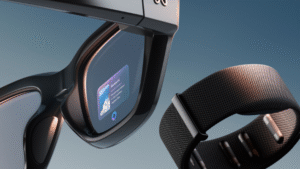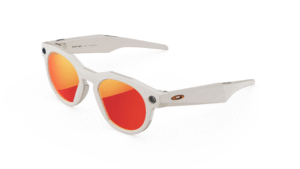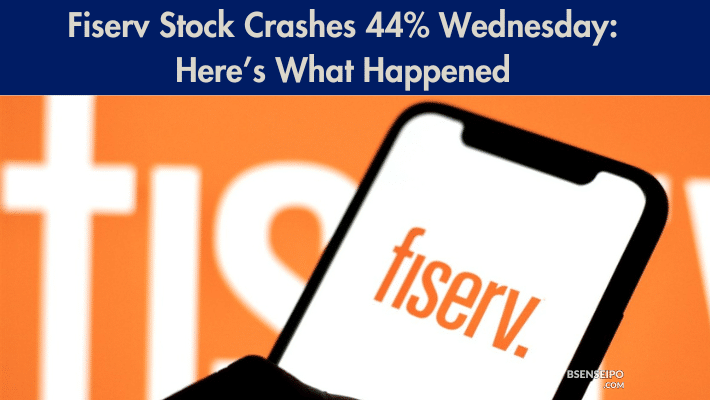Mark Zuckerberg’s unveiling of Meta AI smart glasses
Meta AI Smart Glasses: Meta’s latest smart glasses—from the Ray-Ban Display with built-in lens display to the Oakley Vanguard sporty model—bring AI-powered vision, hands-free control, live translation, and gesture input. Explore specs, pricing, design, and comparisons with rivals in this full breakdown.
Company Background
Meta Platforms, Inc., formerly Facebook, has been investing heavily in augmented reality (AR) and artificial intelligence (AI) as part of its long-term strategy. The company sees wearables—especially smart glasses—as a key frontier in computing beyond the smartphone. Its partnership with Essilor Luxottica (owners of Ray-Ban and Oakley brands) has been central to its smart eyewear efforts. Meta’s annual developer conference, Meta Connect, serves as the stage for major announcements in this space.
The New Product Lineup
At the Meta Connect 2025 event, Meta introduced several new smart glasses:
- – The first version with a built-in display for the right lens; supports messages, navigation, video calls, other visual AI features.
- Oakley Meta Vanguard – A sports/performance-oriented model aimed at athletes, with action camera, integration with fitness platforms like Garmin & Strava, and enhanced durability.
- Ray-Ban Gen 2 / Updated Models – Upgraded non-display Ray-Ban glasses with better battery, camera/video capabilities, and improved features like “conversation focus.”

(Photo Credit – Meta)
(Meta AI Smart Glasses – The new Meta’s Ray-Ban Display glasses have a tiny display screen that only the wearer can see inside the lens.)
Key Features & Specifications
Here are the main technical and design features of Meta AI Smart Glasses:
| Feature | Ray-Ban Display | Ray-Ban Gen 2 / Updated Ray-Ban | Oakley Meta Vanguard |
|---|---|---|---|
| Display | Right-lens built-in HUD (Heads-Up Display) for messages, navigation, etc. | None (screen-free) | None / minimal (focus is performance + action camera) |
| Battery Life (glasses) | ~ 6 hours in normal use; with the case adding ~ 30 more hours via recharging case. | Up to ~ 8 hours; new case gives ~ 48 extra hours. | Specs point toward strong endurance; exact hours depend on usage; designed for athletes. |
| Display Brightness / Visibility | 20-degree field of view; resolution ~ 600 × 600 pixels; brightness from ~ 30 nits up to ~ 5,000 nits. | N/A (no display) | N/A |
| Camera / Video | 12 MP camera; 1080p video recording; works with display for viewfinder etc. | Gen2: 3K video recording in updated version; better color, etc. | Action-focused camera; built for sports usage, possibly wider angle etc. |
| Control Input | Meta Neural Band wristband + gesture controls; voice (“Hey Meta”) etc. | Touches, voice commands; audio cues; open-ear speakers → conversation focus etc. | Gesture, voice; physical buttons may also be more robust for sporting contexts. |
| Features: AI, translation, live captions, vision etc. | Supports live captions, translations; visual results from Meta AI queries; display of messages etc. | Improved features for audio, conversation, better recording etc. | Integration with fitness metrics; automatically capture workout highlights; real-time feedback. |
| Price (US) | US$ 799 | ~ US$ 379 for updated Ray-Ban Gen 2 / non-display version | US$ 499 |

(Photo Credit – Meta)
(Meta AI Smart Glasses – Oakley Vanguard smart glasses )
What Sets the Meta AI Smart Glasses Latest Apart
- Display in lens: The Ray-Ban Display model is Meta’s first consumer glasses with a built-in screen to overlay visuals (navigation, messages etc.) without needing a phone screen.
- Gesture + Neural Band: The wristband (“Neural Band”) that detects micro-gestures plus voice commands allows more natural, hands-free control.
- AI integration: Live captioning, translation, identifying objects, image recognition etc., via Meta AI; multimodal AI that sees and hears.
- Design & branding: Eschewing overt bulky tech-look, with Ray-Ban’s Wayfarer style + classic brands, plus Oakley for sporty looks. Emphasis on style + wearability.
Limitations & Considerations
- The display is only in one lens, and it’s a 2D overlay; not a full field AR or holographic display.
- Battery life depends heavily on usage (display on, video, etc.). Heavy tasks cut into usable time.
- Brightness in direct midday sun might still be a challenge despite high nit rating.
- Features rollout and availability vary by region; some AI features are in beta or early access.
Comparison with Rivals
Here’s how Meta’s new smart glasses stack up against other leading products or expected models.
| Product | Display / HUD | AI / Voice / Gesture | Camera / Video | Battery / Use Case Focus | Price |
|---|---|---|---|---|---|
| Meta Ray-Ban Display | Yes (right-lens display) | Strong: Meta AI, neural band gestures, voice commands, live captions & translation | 12-MP, 1080p recording | 6 h + 30 h with case; oriented toward daily mixed use | US$ 799 |
| Ray-Ban Gen 2 (Non-display) | No | AI features, voice, focus on conversation clarity and audio cues | Upgraded video (3K), better battery | Longer battery; lighter on visuals; more lifestyle focused | US$ 379 |
| Oakley Meta Vanguard | No display; action camera emphasis | AI + fitness integration | Camera tuned for outdoors/sports | Built for athletic / outdoor use; durability, resistance | US$ 499 |
| Google Glass / Google AR (rumored or past) | Partial display; smaller field HUDs vs full AR in future | Voice + limited gesture; historically weaker AI integration | Varies; past models had HD cameras | Mixed; battery constraints, niche use cases | Historically $799-$1,500; depends on model |
| Apple Vision / Rumored AR Glasses | More ambitious AR overlay (rumored) | Deep AI/Spatial computing, though not yet in commercial delivery | Strong sensors; likely high resolution cameras | Likely high power draw; premium pricing expected | Likely > US$ 900 / premium segment |
Impacts & Significance 0f Meta AI Smart Glasses
- Smartphone alternative: Meta is pushing the idea that smart glasses could reduce dependency on pulling out a smartphone for everyday tasks (messages, maps, quick info) by bringing those functions into your field of view.
- Next computing platform: Meta positions these glasses as a step toward “personal superintelligence,” making wearables the next major computing platform after phones.
- Fashion meets tech: By using established eyewear brands and classic designs, Meta is trying to lower the barrier of style, making smart glasses more socially acceptable.
- Privacy & UX trade-offs: Features like always-on microphones, cameras, and vision means questions around privacy, data handling, and social norms will be increasingly important. Also, balancing battery life and usability will remain crucial.
Comparison Chart
| Feature / Metric | Meta Ray-Ban Display | Ray-Ban Gen 2 | Oakley Vanguard | Major Rivals (e.g. Google / Apple etc.) |
|---|---|---|---|---|
| Display in lens / HUD | ✅ (right lens) | ❌ | ❌ | Partial / more advanced but less mainstream yet |
| Gesture / Neural Band | ✅ | limited gestures / touches | Some gesture + robust control | Mixed; gesture work in prototypes, less in mass products |
| AI modes (translation, live captions, object ID) | ✅ | ✅ (but less display-centric) | ✅ (focus on fitness + vision) | Expected in future rivals; some in beta or limited release |
| Camera / Video quality | 12MP, 1080p video | 3K video in Gen 2; better optics | Action camera optimized | Rivals may push higher resolution / AR sensors |
| Battery life (glasses alone) | ~ 6 hours | ~ 8 hours | Sports usage may reduce battery depending on sensor/camera usage | Rivals likely constrained; many prototypes struggle in full-day use |
| Price tier | Premium (~$799) | Mid-premium (~$379) | Mid-premium / sport (~$499) | Likely similar premium pricing when launched |
Meta AI Smart Glasses Pricing
| Model | Price (USD) |
|---|---|
| Ray-Ban Display (with built-in display + Neural Band) | US$ 799 |
| Oakley Meta Vanguard | US$ 499 |
| Ray-Ban Gen 2 (non-display versions) | Starting at US$ 379 with improvements. |
Availability
-
The Meta Ray-Ban Display will be available in the U.S. starting September 30, 2025.
-
It will be sold through a limited set of in-store retailers initially: Best Buy, LensCrafters, Sunglass Hut, Ray-Ban stores in the U.S.
-
International rollout planned for early 2026 in Canada, United Kingdom, France, Italy, etc.
-
The Oakley Meta Vanguard is set to ship from October 21, 2025 in the U.S. and Canada.
-
The Gen 2 Ray-Ban (non-display) versions are available starting at their USD price in some markets shortly after launch.
Conclusion
Meta’s latest AI smart glasses represent a strong push toward making wearable AI more practical. The Ray-Ban Display is especially notable for embedding a display in everyday styles, pairing it with AI features (translations, captions, voice & gesture control) that reduce dependency on smartphones. Meanwhile, the non-display Gen 2 and the Oakley Vanguard serve different niches: more comfort, lifestyle, and sport.
While there are still trade-offs (battery, display field of view, pricing, region-limited features), Meta’s products mark a milestone in bringing AR/AI wearables more into the mainstream. For many users, the question will be: are these features worth paying for now, or does one wait for next-generation devices (with larger display fields, longer battery, etc.)?




